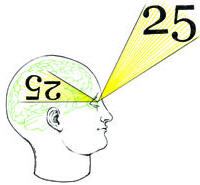Learning is work. Without the proper physical environment, the work necessary for learning cannot take place. Each student needs a place to write and record, time and mechanisms for answering questions, means and methods for examining what they have learned, and extensive and detailed learning aides. There must also be work and study beyond the initial presentation, times when teacher and student are together. Any material important enough to warrant learning is likely to be difficult enough to evade comprehension and understanding at first encounter. So the student must have time outside the classroom to consider what has been presented, to work through problems, and to develop a personal grasp of the material. This used to be called homework.
Learning is uncomfortable. Adult learning is difficult, and if it is to be successful it must take you outside of your comfort zone. There is nothing easy about it: the ready admission of ignorance; the struggle to apprehend and comprehend that which is new, unknown, and uncertain; the summoning of the courage and patience to work through the time of incomprehension; to have our intellectual limits so nakedly exposed; and the slow work toward our own “Aha!” moment. None of this is fun. The result is deeply satisfying, but the process is difficult. If teaching does not challenge, it is unlikely to result in learning.
Learning must matter, and it is rarely powered only by curiosity. The motivation to work at it often requires clear, perhaps immediate, benefits. In this regard, learning needs to be an important part of professional advancement: an aspect of performance review, part of salary-increase considerations, or part of job-advancement evaluations.
Learning must matter, and it is rarely powered exclusively by curiosity. The motivation to work at it often requires clear, perhaps immediate, benefits. In this regard, learning needs to be an important part of professional advancement: an aspect of performance review, part of salary-increase considerations, or part of job-advancement evaluations. As such, learning should not be confused with seminar attendance. One of the baleful effects of attempts to get professionals to continue learning is the Continuing Education Unit. The cottage industry around this form of ticket-punching has made seminar attendance seem equivalent to learning. But stock-piling CEUs is no learning metric.
Meeting the Need with Time and Resources
The detail, depth, and rigor of the learning experiences that are needed are very difficult to provide. The longer seminars (two days, at least) available at a few of the industry’s exhibitions provide some of what is needed. But short seminars have virtually no value, and so the need for learning goes largely unmet.
It is clear that the industry could use at least two annual, week-long, seriously challenging summer schools, modeled somewhat after the Teachers of Lighting Workshop offered by the Illuminating Engineering Society. Away from the distractions of the office—on a college campus, probably—attendees would have six hours of instruction per day, including time in the laboratory and in small-group discussions with teachers, and homework each night. One of these week-long events could be designed to fill the needs of those new to the lighting industry, since the advent of solid-state lighting, such as technical professionals brought from other disciplines. The other event would be targeted for those familiar with lighting, but who need to learn deeply about LEDs, the MLO, and ipRGCs.
But few motivated employees, however eager for or in need of learning, are likely to have the time or money to attend one of the sessions described above, and relegating learning to the odd hour here and there is likely to fail. Better, essential even, would be an industry-wide practice of learning time-sharing: learning time split between the personal time invested by the employee outside of work and time contributed by the employer. This could be accomplished by making learning time part of the work week. Even if the time is available, a learning resource must allow access that fits busy schedules, have segmentation consistent with practically available stretches of time, and provide challenge, activity, and feedback. A traditional textbook cannot provide the activity and feedback, and only addresses one learning style: reading. Better, by far, would be some blend of text, traditional recorded lectures, and advanced video gaming. That is, a mix of the best available technology, suitable for remote access and use: content provide by experts aimed at challenging motivated technical professionals; delivery written, arranged, and paced by professional educators; and feedback content and mechanisms designed by experts and teachers—all packaged and presented by expert designers of virtual realities.
Though the details would be critical to success, they need not be clearly seen in advance to grasp the value that such an interactive learning resource could have for the industry. What is clear now, however, is the requirement for the industry to recognize that most seminars are merely entertainment and that serious learning will require serious commitment. Modern technology needs to be coupled with rigorous learning content and goals, expert teaching, and virtual-reality computer programming to produce the learning resources that the lighting industry needs for the next quarter-century and beyond.
Editor’s note: DiLaura distinguishes between two types of lighting professional, the “lighting designer” and the “illuminating engineer.” They have different backgrounds, educations, and professional activities, and though they sometimes overlap, they approach the implementation of lighting differently.
